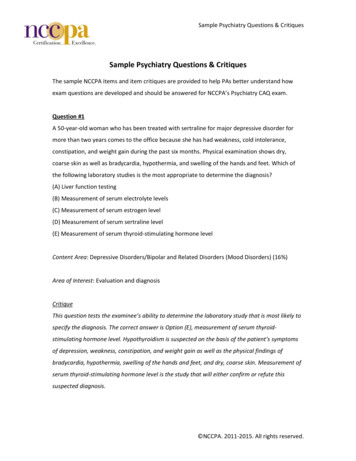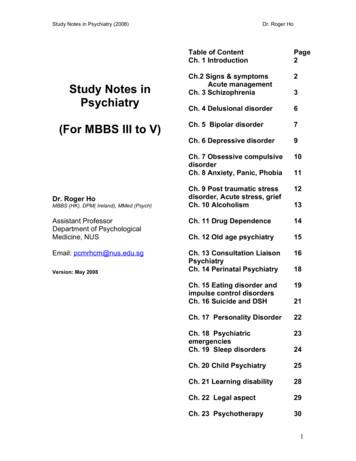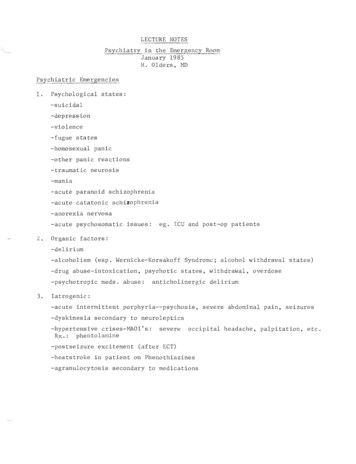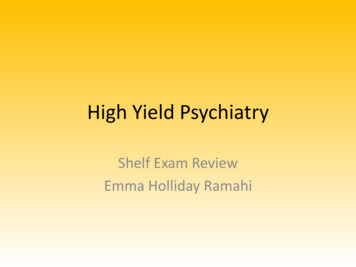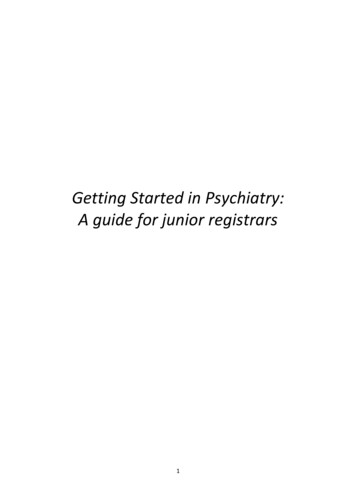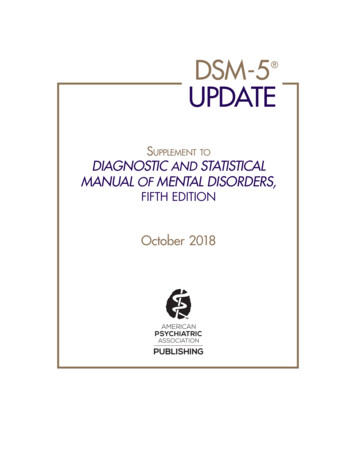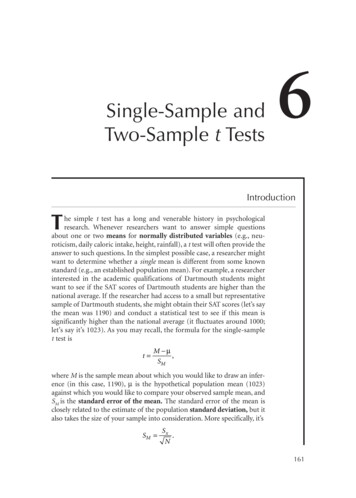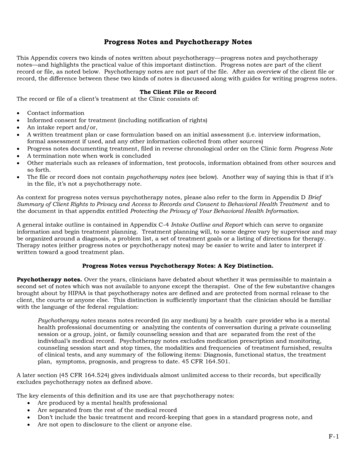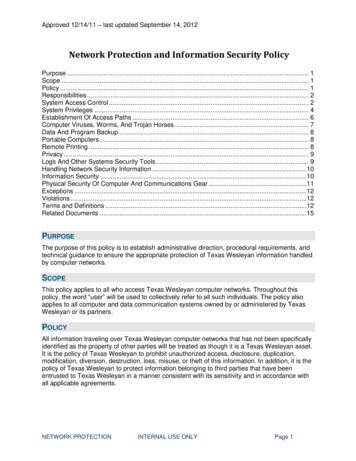
Transcription
SAMPLEPG notes in PSYCHIATRY
SAMPLE
SAMPLEPG notes in PSYCHIATRYCijo Alex
SAMPLENotion PressOld No. 38, New No. 6McNichols Road, ChetpetChennai - 600 031First Published by Notion Press 2015Copyright Cijo Alex 2015All Rights Reserved.ISBN: 97893-5206-402-1This book has been published in good faith that the work of the author is original. All efforts have been taken to makethe material error-free. However, the author and the publisher disclaim the responsibility.No part of this book may be reproduced or transmitted in any form or by any means, graphic, electronic, or mechanical,including photocopying, recording, taping, or by any information storage retrieval system, without the permission, inwriting, from the tesinpsychiatry.org
SAMPLEAuthorDr. Cijo Alex, M.D.Senior Resident in Psychiatry,SMVMCH,PondicherryContributorsDr. Abel K Samuel,PG resident in Community Medicine,PIMS,PondicherryDr. Anoopa Benny,PG resident in Psychiatry,SMVMCH,PondicherryDr. Ceena Alex, MRCGP,General Practioner,Fairfeild surgery,Warrington, UKDr. Jose Mathew MRCPsych,Consultant Psychiatrist and Clinical Director,NHS Foundation Trust,Manchester, UK
SAMPLE
SAMPLEDedicated to Professor R. Kumar, who taught me Psychiatry, and more
SAMPLE
SAMPLEForeword‘PG notes in Psychiatry’ is an impressive effort. It gives a bird’s eye view of Psychiatry in general besides being veryeasy to read and comprehend. It may be described as a compilation of extracts from various textbook chapters,lecture notes, review articles and expert opinions. It has successfully included several topics relevant to PG training,including basic medical sciences, biostatistics, psychology, general psychiatry, specialty psychiatry, neurology andpsychosomatic medicine.In general Psychiatry, emphasis has been given to topics which are more relevant from an examination pointof view. Proper subheadings make it easy to understand and reproduce. The large number of hand drawn pencildiagrams and tabular columns are very useful. It will be a useful tool for PG residents, especially during the timeof their preparation for examinations. Let me congratulate the author Dr Cijo Alex for his hard work and wish allsuccess for this book.Prof Roy Abraham Kallivayalil,Secretary General,World Psychiatric Association,Geneva, Switzerland.
SAMPLE
SAMPLEPreface‘PG notes in Psychiatry’ is best described as a compilation of extracts from various textbook chapters, lecture notes,review articles and expert opinions. Care has been taken to cover most of the relevant topics in Psychiatry, and also topresent it in a clear and crisp format. Through the six sections inside the book, I have tried to include almost all thetopics as required for majority of PG exams, from basic medical sciences to specialty psychiatry. Simple to reproducepencil diagrams and tables have been used in plenty, to facilitate easy understanding. Thus, it can act as a single stopsolution for a PG resident in Psychiatry.The entire idea started to evolve while I was in posted in NIMHANS for training in child and adolescentPsychiatry. Like most of the other external PG’s posted there, me and my colleague Dr. Sanu also got a copy of thepopular NIMHANS notes, written by former PG’s. Despite being elaborate and comprehensive, they had a seriousflaw of being handwritten and photocopied, thus making it difficult to read. Later, during my final exam period, Irealized the need and potential for a comprehensive book, which can help save time, especially in the final year whereyou have lots of things to cover.I would like to express my thanks to all my colleagues and faculty in SMVMCH, Pondicherry, amongwhich Dr. Venkatarangan, Dr. Sanu, Dr. Pradeep and Dr. Hari needs special mention. During my PG training,Dr. Venkatarangan always considered me a future colleague than a student. He also taught me the art of clinicalPsychiatry and history taking, which no text book has on offer. I am also thankful to Prof. Roy Abraham Kallivayalil,Secretary General of World Psychiatric Association (WPA), for consenting to give an inspiring foreword. I wouldalso like to thank my parents, my father being the first psychiatrist in my life. Finally, I am thankful to you forpurchasing this book and I sincerely hope that this would be a worth read. As a maiden attempt, I apologize for anymistakes or omissions that might have occurred. Your feedback regarding the same would be highly appreciated. Iwish you a happy reading and all the best.Warm regards,Dr. Cijo Alex,Olickal,Pala - gnotesinpsychiatry.org
SAMPLE
ContentsSAMPLESECTION ONE: INTRODUCTION TO PSYCHIATRY1. HISTORY OF PSYCHIATRY3Timeline of Psychiatry3The Indian scenario42. CLINICAL EXAMINATION IN PSYCHIATRY7The patient doctor relationship7Transference and counter transference7Interviewing techniques83. GENERAL PSYCHOPATHOLOGY9Perception and disorders of perception9Thinking and disorders of thought11Memory and disorders of memory144. CLASSIFICATORY SYSTEMS IN PSYCHIATRY17ICD 1017DSM 517SECTION TWO: BASIC SCIENCES IN RELATION TO PSYCHIATRY5. NEUROANATOMY21Lobar functions21Limbic system23Basal ganglia25Thalamus26Hypothalamus26Pineal gland26Ventricular system27Blood supply and venous drainage of the brain27Facial nerve anatomy28Visual pathway286. NEUROPHYSIOLOGY29Autonomic nervous system29Reticular activating system29Neuro endocrinology30Neuro immunology30Chronobiology and circadian rhythm31
xiv ction33SAMPLE7. NEUROCHEMISTRY35Neurotransmitters35Novel neurotransmitters38Second messengers398. GENETICS41Glossary of important terms41Patterns of inheritance41Study designs in genetics42Genetic counseling42Human genome project429. RESEARCH METHODS43Types of research methods43Evidence based medicine44Components of research methods45SECTION THREE: PSYCHOLOGY10. INTRODUCTION5111. PSYCHOANALYSIS5312. PERSONALITY5913. LEARNING6114. INTELLIGENCE6515. EMOTIONS6716. MOTIVATION6917. MEMORY7118. LEARNED HELPLESSNESS7319. ATTACHMENT THEORY7520. SOCIAL PSYCHOLOGY7721. PSYCHODIAGNOSTICS79SECTION FOUR: CORE PSYCHIATRY22. SUBSTANCE USE DISORDERS85Terminology85Alcohol use disorders85Other substance use disorders90
Contents xv23. SCHIZOPHRENIA AND OTHER PSYCHOTIC DISORDERS93Historical evolution of the concept of schizophrenia93Etiology of schizophrenia95Types of schizophrenia98Scales used in schizophrenia99Treatment of schizophrenia99SAMPLECourse and outcome of schizophrenia100Negative symptom schizophrenia101Catatonia102Landmark studies in schizophrenia103Smoking and schizophrenia104Treatment resistant schizophrenia104Other psychotic disorders10624. MOOD DISORDERS109Etiology of affective disorders109Mania and BPAD111Other topics related to mania and BPAD113Depression114Other topics related to MDD116Dysthymia118Cyclothymia119Landmark studies in mood disorders11925. NEUROTIC, STRESS RELATED AND SOMATOFORM DISORDERS121Generalized anxiety disorder124OCD125Acute stress reaction and PTSD126Adjustment disorder127Dissociative disorder127Somatoform disorders128Other neurotic disorders13026. BEHAVIORAL SYNDROMES133Eating disorders133Sleep disorders134Sexual disorders13627. PERSONALITY DISORDERS, IMPULSE CONTROL DISORDERSAND FACTITIOUS DISORDERS139Personality disorders139Impulse control disorders142Factitious disorders143
xvi Contents28. BIOLOGICAL THERAPIES145General principles of psychopharmacology145Antipsychotics147Mood n stimulation techniques154MECT154Psychosurgery156SAMPLESECTION FIVE: SPECIALITY PSYCHIATRY29. CHILD AND ADOLESCENT PSYCHIATRY15930. WOMEN AND MENTAL HEALTH16931. GERIATRIC PSYCHIATRY17332. EMERGENCY PSYCHIATRY17733. PSYCHOTHERAPY18134. FORENSIC PSYCHIATRY18935. COMMUNITY PSYCHIATRY19336. MENTAL HEALTH LEGISLATIONS IN INDIA19537. NEUROIMAGING, EEG AND EVOKED POTENTIALS19738. BIOMARKERS, SOFT SIGNS AND PRIMITIVE REFLEXES20339. OTHER SPECIALTY PSYCHIATRY TOPICS205Rehabilitation205Global burden of mental illness206Migration and mental illness207Laboratory investigations in Psychiatry207Alternative medicine and Psychiatry208SECTION SIX: NEUROLOGY IN RELATION TO PSYCHIATRY40. DEMENTIA21141. EPILEPSY21942. STROKE22543. NEUROINFECTIONS22744. DELIRIUM23145. TRAUMATIC BRAIN INJURY23346. HEADACHE23747. APHASIA AND APRAXIA23948. OTHER NEUROLOGY TOPICS241Bell’s palsy241
Contents xviiTrigeminal neuralgia241Cerebral venous sinus thrombosis241Kindling phenomenon242Other movement disorders242Gait disorders242Multiple sclerosis243Neuromuscular diseases243Neurocutaneous syndromes243Plantar reflex244SAMPLE49. PSYCHOSOMATIC MEDICINE24550. OTHER GENERAL MEDICINE TOPICS249Organic amnesic syndrome249Neuropsychiatric aspects of thyroid disorders249Diabetes ic aspects of nutritional deficiencies251
SAMPLE
SAMPLESECTION ONEINTRODUCTION TO PSYCHIATRY
SAMPLE
Chapter OneSAMPLEHistory of PsychiatryPsychiatry literally means medical treatment of the soul. The word ‘Psyche’ originated fromthe ancient Greek for soul or butterfly. Psi (Ψ) is the 23rd letter of the Greek alphabet,and is often used as a symbol of Psychiatry. Psychiatrist is a physician who specializes inthe field of Psychiatry. It was the German physician Johann Christian Reil who coined theterm ‘Psychiatry’ in 1808, and he is considered the father of Psychiatry. He was the first todescribe the white fiber tract now called the arcuate fasciculus. William Griensinger was aneurologist from Germany who believed that all mental disorders are brain diseases. Heis considered the father of Neuropsychiatry, and his concepts are gaining more and moreevidence with advances in the field of biological Psychiatry.Timeline of PsychiatryAs correctly said, history is a screen through which the past enlightens the present, and the present brightens thefuture. The time line of Psychiatry described best described after classifying into distinct time periods or ages, for theease of understanding. History of Psychiatry is an elaborate topic and only very few important aspects are describedbelow.The age of rationalismThe period between 500 bc and 500 ad is considered the age or rationalism or the golden age in medicine.Hippocrates, who is considered the father of medicine, was among the first to describe mental illnesses. He describedfour body humors and believed that their imbalance resulted in illness. Hippocrates rejected demonic invasions andsuggested brain pathology as the cause of mental illness. Galen in Rome, and Charaka and Susruta in India alsoproposed organic cause for mental disorders.The dark agesFall of Roman Empire was followed by a decline in scientific interest andmedical research. Religion took dominance over science, and this age canbe described as a period of intellectual stagnation. Mentally ill patients wereoften treated cruelly. ‘Malleus Maleficarum’ (The witch hammer) was aninfluential book written by German clergy men, which proposed torturingand killing of the people with mental illness. The dark ages also witnessed riseof mental asylums, many of which resorted to cruel and inhumane treatmentof the mentally ill. Baghdad mental asylum, the first mental asylum in worldwas setup in 705 ad. Bethlem hospital, London was the first major, modern psychiatric hospital, which was openedin 1247 ad. Most of these early age hospitals were merely custodial centers, with little emphasis on cure.Contemporary PsychiatryPhilippe Pinel was the pioneer in unchaining, and advocating humane treatment to the mentally ill. He classifiedinsanity into four categories of mania, melancholia, idiocy and dementia. Esquirol was a student of Pinel, and hehas contributed a lot to descriptive psychopathology. Later, it was the German physician Johann Christian Reil who
4PG notes in PSYCHIATRYcoined the term ‘Psychiatry’ in 1808 and he is considered the father of Psychiatry. He also started the first journalin Psychiatry.SAMPLEBenedict Morel was the French psychiatrist who coined the term ‘Demence Precoce’, to denote illness similarto modern day schizophrenia. Later, Emil Kraeplin and Eugene Bleuer elaborated on the Morels idea of ‘DemencePrecoce’. Emil Kraeplin divided mental disorders into ‘dementia precox’, and ‘manic depressive illness’. EugeneBleuer coined the term schizophrenia, and described primary and secondary symptoms of schizophrenia. Jaspers,Schneider and Mayor Gross were prominent German psychiatristswho contributed much to the study of psychopathology.Anti psychiatry - Anti psychiatry was a movement against the conceptof psychiatry and psychiatric illnesses. The term anti psychiatry wascoined by David Cooper. Other major proponents of anti psychiatryincluded Thomas Szasz, Theodore Lidz etc. They all claimed thatpsychiatrists are doing harm to the patients rather than helping themout. They considered mental illness a myth and proposed that mindis not a bodily organ, and hence cannot be treated. However, the antipsychiatry movement could not stand the test of time, though it is a favorite theme in the general viva, duringuniversity examinations.The Indian scenarioAncient Ayurvedic manuscripts like ‘Charaka Samhita’ and ‘Sushruta Samhita’ do mention about mental disorders.The ancient Indian literature ‘Atharva Veda’ considers mental illnesses as resulting from divine curses. It also includesa vivid description of modern day schizophrenia. ‘Bhagavat Geetha’ can be considered a classical example of crisisintervention and psychotherapy. The traditional medical system of Unani classifies seven types of mental disorders.King Asoka has established hospitals to cater mentally ill patients. The first formal psychiatric hospital in India wasstarted in Bombay, by 1745. This was followed by similar institutions in Calcutta and Madras. Girindhra Shekar Bosewas a prominent psychoanalyst, and he found
‘PG notes in Psychiatry’ is best described as a compilation of extracts from various textbook chapters, lecture notes, review articles and expert opinions. Care has been taken to cover most of the relevant topics in Psychiatry, and also to present it in a clear and crisp format. Through the six sections inside the book, I have tried to include almost all the topics as required for majority .
